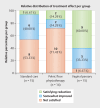Comparison of Vaginal Pessaries to Standard Care or Pelvic Floor Muscle Training for Treating Postpartum Urinary Incontinence: a Pragmatic Randomized Controlled Trial
- PMID: 38455997
- PMCID: PMC10917606
- DOI: 10.1055/a-2243-3784
Comparison of Vaginal Pessaries to Standard Care or Pelvic Floor Muscle Training for Treating Postpartum Urinary Incontinence: a Pragmatic Randomized Controlled Trial
Abstract
Introduction: To compare three conservative treatment options, standard care, pelvic floor muscle training (PFMT), and vaginal pessaries, for postpartum urinary incontinence (UI) that are accessible to most patients and practitioners in a generalizable cohort.
Materials and methods: A multicenter, open-label, parallel group, pragmatic randomized controlled clinical trial comparing standard care, PFMT, and vaginal cube pessary for postpartum urinary incontinence was conducted in six outpatient clinics. Sample size was based on large treatment effects (Cramers' V > 0.35) with a power of 80% and an alpha of 0.05 for a 3 × 3 contingency table, 44 patients needed to be included in the trial. Outcomes were analyzed according to the intention-to-treat principle. Group comparisons were made using analysis of variance (ANOVA), Kruskal-Wallis, and chi-square test as appropriate. P < 0.05 was considered statistically significant.
Results: Of the 516 women screened, 111 presented with postpartum UI. Of these, 52 were randomized to one of three treatment groups: standard care (n = 17), pelvic floor muscle training (n = 17), or vaginal cube pessary (n = 18). After 12 weeks of treatment, treatment success, as measured by patient satisfaction, was significantly higher in the vaginal pessary group (77.8%, n = 14/18), compared to the standard care group (41.2%, n = 7/17), and the PFMT (23.5%, n = 4/17; χ 2 2,n = 52 = 14.55; p = 0.006, Cramer-V = 0.374). No adverse events were reported. SUI and MUI accounted for 88.4% of postpartum UI.
Conclusion: Vaginal pessaries were superior to standard care or PFMT to satisfyingly reduce postpartum UI symptoms. No complications were found.
Einleitung: Ziel war es, 3 konservative Optionen zur Behandlung der postpartalen Harninkontinenz in einer verallgemeinerbaren Kohorte zu vergleichen. Verfügbare Behandlungsoptionen waren Standardversorgung (Rückbildungskurse), Beckenbodenphysiotherapie und Pessare, die den meisten Patientinnen und Behandelnden zur Verfügung stehen.
Material und methoden: Es wurde eine multizentrische offene pragmatische randomisierte kontrollierte klinische Studie mit parallelen Gruppen durchgeführt. Die Outcomes nach Standardversorgung (Rückbildungskurse), Beckenbodenphysiotherapie oder Würfel-Pessaren zur Behandlung von postpartaler Harninkontinenz wurden in 6 Arztpraxen verglichen. Zum Nachweis eines großen Behandlungseffektes (Cramers V > 0,35) mit einer Teststärke von 80% bei einem Alpha von 0,05 für eine 3 × 3-Kontingenztabelle wurde eine Stichprobengröße von mindestens 44 Patientinnen errechnet. Die Outcomes wurden nach dem Intention-to-treat-Prinzip analysiert. Die Gruppen wurden mithilfe der Varianzanalyse (ANOVA) sowie Kruskal-Wallis- und Chi-Quadrat-Test verglichen. Der p-Wert für die statistische Signifikanz betrug < 0,05.
Ergebnisse: Von den 516 untersuchten Frauen hatten 111 eine postpartale Harninkontinenz. Von diesen Frauen wurden 52 in jeweils eine der 3 Behandlungsgruppen randomisiert: Standardversorgung (Rückbildungskurse, n = 17), Beckenbodenphysiotherapie (n = 17) und Würfel-Pessare (n = 18). Nach 12 Wochen Behandlungszeit war der an der Patientinnenzufriedenheit gemessene Behandlungserfolg signifikant höher in der Pessar-Gruppe (77,8%, n = 14/18) verglichen mit den Gruppen Standardversorgung (Rückbildungskurse, 41,2%, n = 7/17) und Beckenbodenphysiotherapie (23,5%, n = 4/17; χ 2 2,n = 52 = 14,55; p = 0,006, Cramers-V = 0,374). Es gab keine unerwünschten Ereignisse. Belastungsinkontinenz und Mischinkontinenz machten 88,4% der Fälle mit postpartaler Harninkontinenz aus.
Schlussfolgerung: Es stellte sich heraus, dass für eine zufriedenstellende Reduktion von Symptomen der postpartalen Harninkontinenz Pessare der Standardversorgung (Rückbildungskurse) und der Beckenbodenphysiotherapie überlegen waren. Komplikationen sind keine aufgetreten.
Keywords: pelvic floor muscle training; postpartum; randomized controlled trial; standard care; urinary incontinence; vaginal pessary.
The Author(s). This is an open access article published by Thieme under the terms of the Creative Commons Attribution-NonDerivative-NonCommercial-License, permitting copying and reproduction so long as the original work is given appropriate credit. Contents may not be used for commercial purposes, or adapted, remixed, transformed or built upon. (https://creativecommons.org/licenses/by-nc-nd/4.0/).
Conflict of interest statement
Conflict of Interest Sören Lange: None. Elham Tabibi: None. Rainer Lange: Shareholder of coma-urogyn GmbH, received payment for research from Coloplast. Thomas Hitschold: None. Veronika I. Müller: None. Gert Naumann: Received payment for research and travel expenses/honoraria from Promedon.
Figures



References
LinkOut - more resources
Full Text Sources

